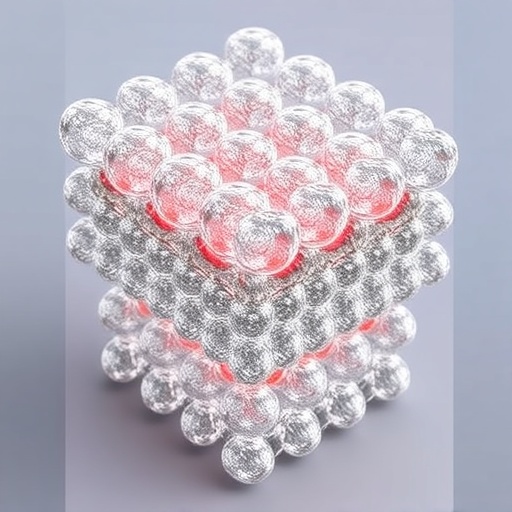Recent advancements in the realm of energy storage systems have brought renewed attention to the potential of supercapacitors. These devices, characterized by their ability to deliver quick bursts of energy and remarkable longevity, play a crucial role in modern electronics. One particularly promising area of research has been focused on the optimization of electrode materials to enhance the performance of supercapacitors. In a groundbreaking study, researchers have explored the application of barium-doped magnesium tin oxide (Ba-doped MgSnO₃) as a high-performance electrode material.
The study, led by Abdelmohsen and his team, has demonstrated that Ba-doped MgSnO₃ can significantly improve the efficiency and overall performance of supercapacitors. The exploration of metal oxides in energy storage applications is not new, but the meticulous optimization in this study marks a pivotal moment for the advancement of supercapacitor technology. Researchers have been eager to find materials that not only demonstrate excellent electrical conductivity but also offer structural stability and high surface area – factors critical to the performance of supercapacitors.
The optimization process involved the careful doping of magnesium tin oxide with barium. This substitutional doping allowed the researchers to tweak the electronic properties of the material, enhancing charge storage capacity and conductivity. The intricate balance between composition and structural integrity is what enabled Ba-doped MgSnO₃ to stand out among other candidates. Understanding the material’s crystal structure and electronic configuration played an essential role in the success of this optimization.
Moreover, the Ba-doped MgSnO₃ was subjected to rigorous testing under various conditions to assess its performance metrics. Through a series of electrochemical tests, the researchers evaluated parameters such as specific capacitance, cyclic stability, and energy density. The results were astounding, showcasing the potential of this innovative material to outperform conventional electrode materials used presently in supercapacitor technology.
The application of Ba-doped MgSnO₃ is not limited to supercapacitors alone. Its unique properties could pave the way for a multitude of applications across different fields, ranging from renewable energy storage solutions to advanced electronic devices. This adaptability in material performance is crucial, especially as the global demand for efficient energy storage solutions continues to rise.
Another fascinating aspect of this research is the study of the interaction between the dopant and the host lattice. The team delved into the electronic structure changes induced by barium doping, providing invaluable insights into how these modifications enhance charge carrier mobility. This fundamental understanding of how doping influences material properties lays the groundwork for future studies aimed at discovering even more efficient electrode materials.
The optimization process also involved assessing the environmental impact and sustainability of the materials used. Given the pressing need for green technologies, the team ensured that the synthesis process for Ba-doped MgSnO₃ was not only economically viable but also environmentally friendly. This commitment to sustainability reflects a growing trend in materials science, where researchers are increasingly aware of the ecological footprint of their innovations.
With the rapid advancements in nanotechnology, the researchers were able to create nanoscale structures of Ba-doped MgSnO₃, significantly increasing surface area and enhancing electrochemical performance. The creation of these nanostructures is a game-changer in the field, as it directly correlates to improved performance metrics for supercapacitors. This innovative approach could lead to the development of more compact and efficient energy storage devices, thereby revolutionizing portable electronics.
Furthermore, the thermal stability of Ba-doped MgSnO₃ was rigorously evaluated. Supercapacitors often face thermal challenges during operation, and the resilience of the electrode material is paramount for device longevity. The study confirmed that Ba-doped MgSnO₃ maintains structural integrity and continues to perform effectively, even under elevated temperatures. Such findings bolster confidence in deploying this material for various real-world applications.
As researchers continue to publish findings and subsequent studies emerge, the implications of Ba-doped MgSnO₃ extend toward potential commercialization. With a foundation of solid experimental data demonstrating its efficacy, this material could soon transition from research labs to commercial applications. This pathway highlights the collaboration between academia and industry, which is essential for translating scientific discoveries into usable technologies.
The combination of performance, sustainability, and adaptability positions Ba-doped MgSnO₃ as a frontrunner in the search for next-generation supercapacitor materials. As demand for fast-charging and long-life energy solutions burgeons, research efforts like these are more crucial than ever. The findings from this study hold promise not just for supercapacitors, but for a host of other energy storage applications, propelling advancements in a variety of sectors.
In summary, the optimization of Ba-doped MgSnO₃ has unveiled new horizons for electrode materials in supercapacitor technology. The significant improvements in charge storage capacity, cycling stability, and thermal resilience are indicative of the transformative potential this material holds. As the field of energy storage continues to evolve, innovations like Ba-doped MgSnO₃ offer a glimpse into a more efficient and sustainable future.
In conclusion, the journey of Ba-doped MgSnO₃ represents the intersection of thorough research, innovative material science, and the urgent need for advanced energy storage solutions. Given the rapid advancements in technology, studies like this will undoubtedly catalyze further exploration into the realm of supercapacitor applications, driving us toward a more efficient energy landscape.
Subject of Research: Ba-doped MgSnO₃ as a high-performance electrode material for supercapacitors.
Article Title: Optimized Ba-doped MgSnO₃ as a high-performance electrode material for supercapacitor applications.
Article References: Abdelmohsen, S.A.M., Alyousef, H.A., Alqarny, A.S. et al. Optimized Ba-doped MgSnO₃ as a high-performance electrode material for supercapacitor applications. Ionics (2025). https://doi.org/10.1007/s11581-025-06617-2
Image Credits: AI Generated
DOI: https://doi.org/10.1007/s11581-025-06617-2
Keywords: supercapacitors, energy storage, Ba-doped MgSnO₃, electrode materials, optimization, sustainability, nanotechnology.




